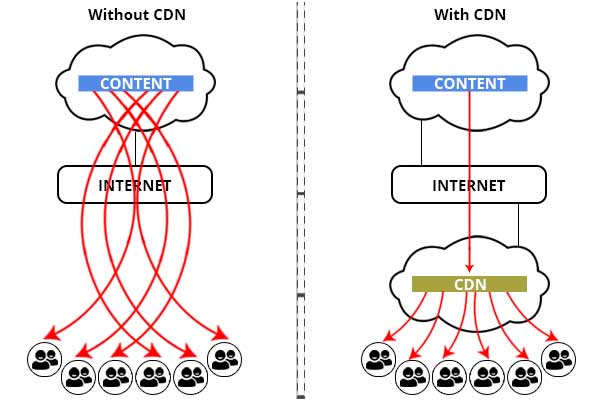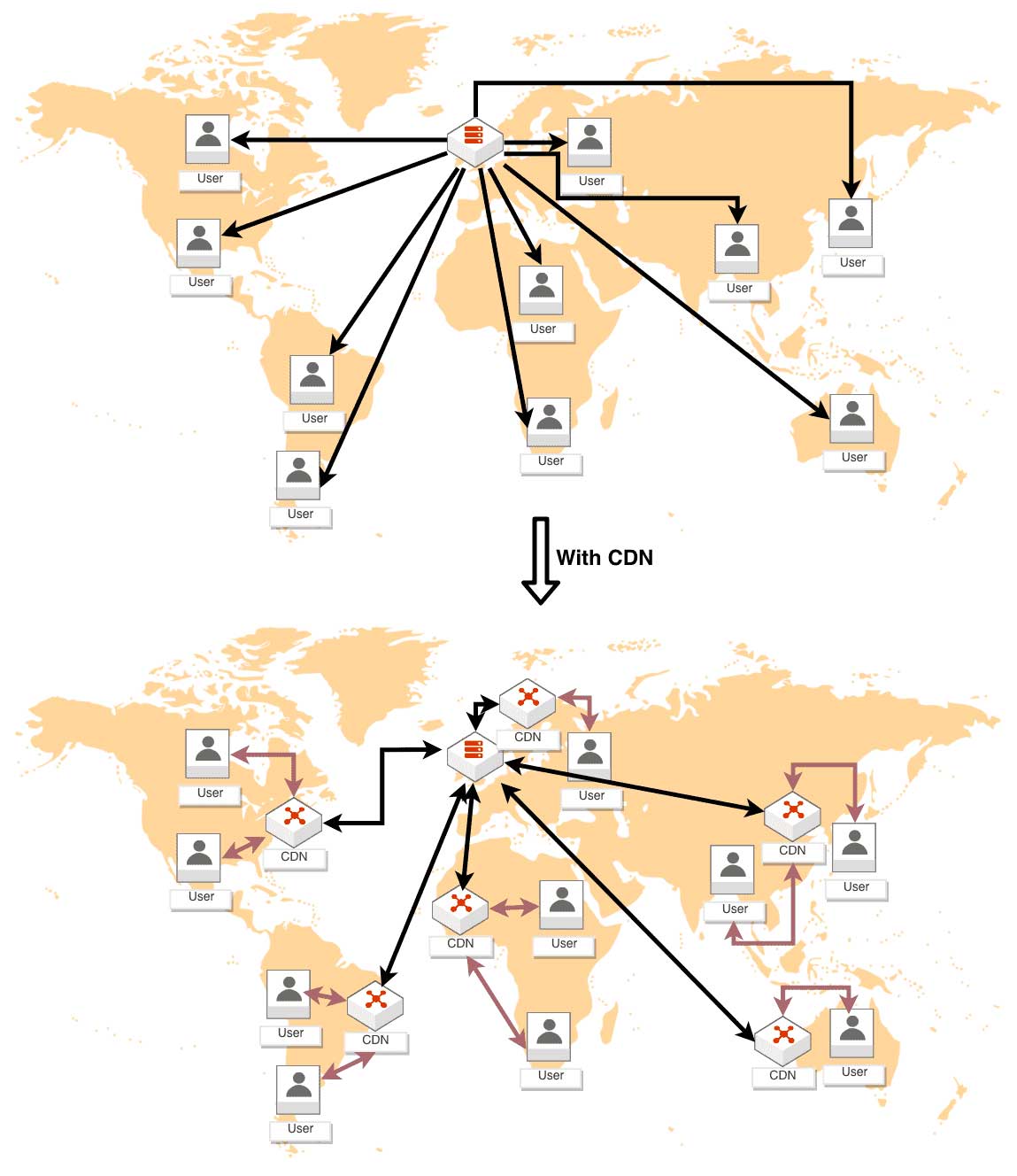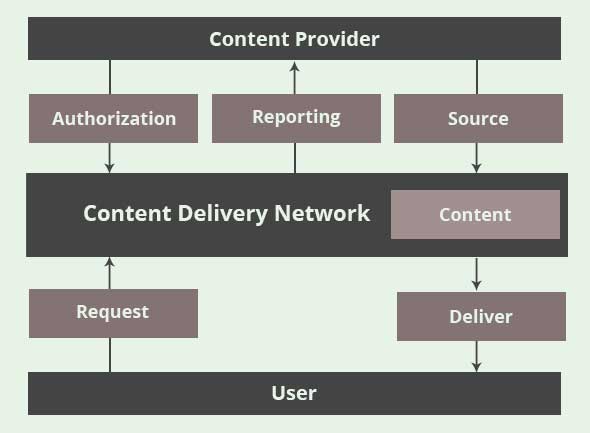Use a Content Delivery Network (CDN): The Best Way to Increase Your Website’s Performance
Aug 04, 2020 | 06 min read
2. What is a Content Delivery Network?
CDN stands for Content Delivery Network. A content delivery network is a system or is a group of servers that distributes servers ( network) in different locations. The servers that deliver web content and pages to the user, based on the user’s geographic location.
Closer the CDN server geographically to the user, the faster content will be loaded on the user’s device. This service is successful and effective in speeding the delivery of content of websites with high traffic.
High content loading speed = positive User Experience. The purpose of a CDN is to improve user experience and provide it with a more efficient network resource utilization. CDN distributes the content delivery load through the server closest to your visitor’s location, making the best user experience.
Pictorial Representation of CDN
Let’s understand from the pictorial representation of CDN.
The first image is about the network Without CDN which shows there is only one original server. When a user requests for any web content the delivered time will be more if the distance between the user and main server is long.
The second image represents an image of With CDN which describes there are various CDNs located in different locations around the world. So that the page will load fast in the user’s device as the content will be load from the CDN which is geographically closer to the user.
3. How Shopify’s CDN Works
A Content Delivery Network or Content Distribution Network (CDN) is a group of servers distributed around the world.
Since more e-commerce sites are going globally, a CDN—or in the case of Shopify, dual CDNs—is a non-negotiable ingredient for platform performance.
Shopify offers a world-class CDN powered by Fastly at no extra cost. Shopify stores will come up almost instantaneously anywhere in the world, including the U.S., U.K., South America, southern Africa, the Australia, and New Zealand (APAC) region, and Asia.
Shopify informs the CDN when your assets (e.g. images, JavaScript, and CSS) had changed. You can use the asset_url filter and automatically append version numbers to all of the URLs that will get generate.
For example, a version number appended to the end of a URL might look like this: ?v=1384022871. The versioning ID added automatically via the asset_url filter tells the CDN to pull the correct version. Without the version ID you may not see the asset you expect after you had made changes to your content, so using an asset_url filter to link to an image is necessary.
Additionally, if you reference content directly in your CSS, the URL will be static. It also not carry the asset version that Shopify updated automatically. To ensure automatic updates, change your CSS syntax to include the asset_url filter.
4. How do CDNs Help to Solve Latency Issues?
Content delivery network or CDN is the method used by a lot of website owners to solve the problem of latency. Latency refers to the length of time it takes for content to be delivered after a request has been sent from a web visitor.
The main problem is the far a web visitor is located from the server, the longer the travel of the web request will be. Also, if there is high traffic, the origin server can take a while to respond to all requests. As a result, it leads to high latency and slow web page loading time.
CDNs work through a network that is located servers spread out around the world geographically. These servers are called as Point of Presence or PoP servers.
The host origin server will send a copy of the files and elements of its web pages to the PoP servers. These servers will then cache these elements and files.
When a web page request is made, it is sent to the nearest PoP server instead of the host origin server. The PoP server will then deliver the cached version of the web page to the device of the web visitor.
This process achieves two things.
- The traveled distance of web request gets shortens
- The amount of traffic handled at the host origin server get reduced. As a result, the origin host server is not overburdened and web pages load faster.
5. CDN Key Components
Here’s a simple model of a Content Delivery Network, its key components explained below:
-
Content Provider:The entity delivering the content
-
Authorization:The Content Provider gives the CDN Provider permission to deliver content
-
Reporting:The Content Provider demands performance analytics from the CDN Provider to evaluate the quality of the CDN Provider’s service and have access to other relevant data
-
Source:The Content Provider sends a copy of the content
-
Content:Digital information created or licensed for distribution
-
Request:The user requests from the Content Provider to view or locally store data (content)
-
Deliver:CDN delivers the content to the user
-
User:Entity requesting data (content) from the Content Provider
6. Benefits of Content Delivery Network
Global accessibility
Content Delivery Networks help to make content globally available and accessible, solving the problem of content source and destination of having multiple Points of Presence (PoPs). This facilitates the global business transaction and eliminates disturbances (slow or unsuccessful transactions).
Less Delays
CDNs use globally accessible servers and copy of the content. Their end users are usually closer to PoPs than the main servers which make for fewer delays in content delivery.
Protection against DDoS attacks
What are DDoS attacks?
DDoS stands for Distributed denial-of-service attacks target websites and online services. The aim is to overwhelm them with more traffic than the server or network can accommodate. The goal is to render the website or service inoperable.The use of CDNs provides protection against DDoS attacks.
Increased Reliability and Trustworthiness
There is a very high probability the content delivered through CDNs will maintain optimal quality in comparison with content delivered through other sources.
CDNs are designed so content could be distributed at a faster rate. This makes the factual information shared more trustworthy, which has a positive effect on your customer satisfaction.
CDNs are designed so content could be distributed at a faster rate. This makes the factual information shared more trustworthy, which has a positive effect on your customer satisfaction.








